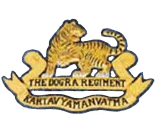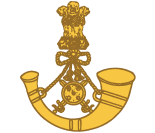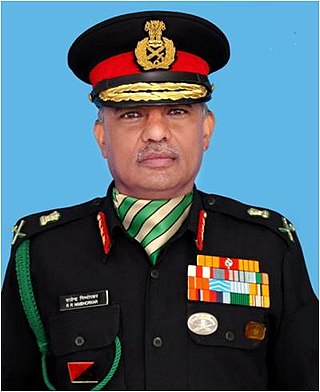
The Dogra Regiment is an infantry regiment of the Indian Army. The regiment traces its roots directly from the 17th Dogra Regiment of the British Indian Army. When transferred to the Indian Army like its sister regiments, the numeral prefix was removed. Units of the Dogra Regiment have fought in all conflicts that independent India has been engaged in, making it one of the most prestigious and most decorated regiments of the Indian Army.

The Parachute Regiment is an airborne and special forces regiment of the Indian Army. It was raised in 1945 as part of the British Indian Army but was disbanded after World War II and was re-raised in 1952 as part of the Indian Army. Currently it consists of fifteen Special Forces, two Territorial Army and one Rashtriya Rifles battalions.

The Kumaon Regiment is one of the oldest infantry regiments of the Indian Army. The regiment traces its origins to the 18th century and has fought in every major campaign of the British Indian Army and the Indian Army, including the two world wars, and is one of the highest decorated regiments of the Indian Army.

The Maratha Light Infantry is a light infantry regiment of the Indian Army. It traces its lineage to the Bombay Sepoys, raised in 1768, making it the most senior light infantry regiment in the Indian Army.

The Poona Horse is an armoured regiment in the Armoured Corps of the Indian Army. The regiment, known before independence as The Poona Horse, was raised as a regular cavalry regiment in the Bombay Presidency army of the East India Company. It was formed from the 3rd Regiment of Bombay Light Cavalry, raised in 1820, and the Poona Auxiliary Horse, raised about 1817–18. The latter unit was absorbed into the regular forces about 1860 and the two regiments later became the 33rd Queen Victoria's Own Light Cavalry and the 34th Prince Albert Victor's Own Poona Horse.

The Garhwal Rifles, formerly known as the Royal Garhwal Rifles, are an infantry regiment of the Indian Army. It was originally raised in 1887 as the 39th (Garhwal) Regiment of the Bengal Army. It then became part of the British Indian Army, and after the Independence of India, it was incorporated into the Indian Army.
Lieutenant General Zorawar Chand 'Zoru' Bakshi PVSM, MVC, VrC, VSM was a General Officer of the Indian Army, most widely known as one of the commanders of Indo-Pakistani War of 1965. He also has the distinction of being "India's most decorated General".

The Regiment of Artillery is a combat/fighting arm of the Indian Army, which provides massive firepower during all ground operations of the Indian Army. It is a successor to the Royal Indian Artillery (RIA) of British Indian Army, which itself traces its origins to the formation of Bombay Artillery in 1827.

The XIV Corps or The Fire and Fury Corps is a corps of the Indian Army. It is the Army's Udhampur-based part of the Northern Command. The 14th Corps forms a military deployment in the Kargil-Leh area guarding the frontiers with China and Pakistan. It also guards the Siachen Glacier.

Lieutenant General Rajendra Ramrao Nimbhorkar, PVSM, UYSM, AVSM, SM**, VSM is a former officer of the Indian Army who served as the Master General Ordnance (MGO). He assumed office on 9 August 2017 after Lieutenant General Ravi Thodge retired. He was part of one of the strike corp which was responsible for carrying out three strikes inside POK in Surgical Strikes held in 2016 by the Indian Army to clean out all the Pakistani Terrorists Camps. As surgical strikes were carried out very secretly to maintain surprise, so very few people knew of them, one of those involved was Lt. Gen. Nimbhorkar.

Lieutenant General (Dr) Jaiveer Singh Negi PVSM, AVSM, YSM, VSM** is a retired General Officer who has served as the 49th Commandant of the Indian Military Academy. He took over from Lieutenant General Sanjay Kumar Jha, PVSM, AVSM, YSM, SM, on 1 February 2020. Prior to his appointment as Commandant of the Indian Military Academy, he was the Deputy Commander-in-Chief of Strategic Forces Command

9 Parachute Field Regiment is part of the Regiment of Artillery of the Indian Army.
79 Medium Regiment is part of the Regiment of Artillery of the Indian Army.
1851 Light Regiment is part of the Regiment of Artillery of the Indian Army.
The 194 Field Regiment is part of the Regiment of Artillery of the Indian Army.
101 Field Regiment is part of the Regiment of Artillery of the Indian Army.
90 Field Regiment is part of the Regiment of Artillery of the Indian Army.
94 Field Regiment is part of the Regiment of Artillery of the Indian Army.
67 Field Regiment is part of the Regiment of Artillery of the Indian Army.










